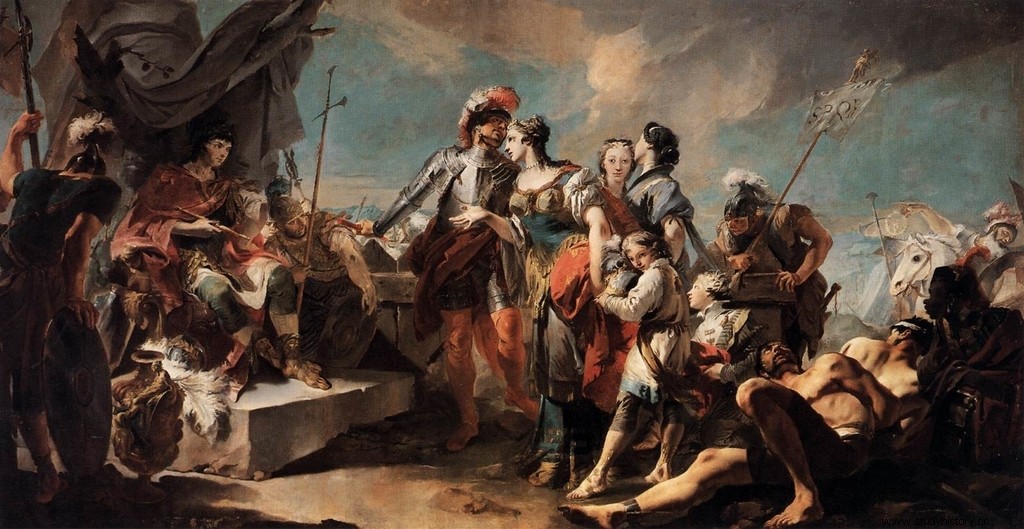It can be said that the most popular era in world history is the era of the Three Kingdoms in the late Han Dynasty. It is so popular that it can be made into various movies, manga, novels, and even games, and has many fans in Japan as well as during the Warring States period.
I think few people know that Rome was actually divided into three countries in the 3rd century, which was almost the same as the time of the Three Kingdoms. It doesn't appear in high school history textbooks at all, and if it's not made into a game, it's probably not a cartoon or a movie.
This time, I would like to take a look at such Roman Three Kingdoms.
Emperor Gallianus and the Tripartite Division

The Roman Empire split into three during the time of Emperor Gaelianus around 260 AD.
Who is Emperor Gallianus? It may seem like that, but he is the only son of Emperor Valerianus, who was captured by an enemy country in Roman history. He might even feel like he's not a world history choice ...
The days of Emperor Gallianus were tough. The Sassanid dynasty is invading from the west, and the Germanic people are invading from the north. In such a state, Postumus is Gallic Empire in the western Gaul region. In eastern Syria, Zenobia, the wife of Eastern Commander Odana Etus, Palmyra Empire Was established and became independent.

Gaelianus was forced to steer more difficult than any other emperor of all time, but he did not seem to have the power needed to survive this difficult time.
Palmyrene Empire
Let's start with the Palmyrene Empire.
Emperor Valerianus was captured during the Sassanid Empire, and the Eastern Front of Rome was anomalous.
The emperor was unable to deal with the Germanic people in the north, and instead had the problem of who would fight the Sassanid Empire.
It was Septimius Odaenathus, a man in the trading city of Palmyra, where the arrow of white feathers stood. He had organized his own vigilantism against the Sassanid Empire, and when he saw it, Emperor Gallienus appointed him the Commander-in-Chief of the East. It is the de facto empire number two.
In 267, when Septimius Odaenathus was killed by his nephew with his son, Vaballathus, the son of his second wife Zenobia, declared the establishment of the Palmyrene Empire and became the emperor himself.
The nephew was quickly treated by Zenobia, joined hands with the Sassanid Empire, and reigned as a queen, with Syria and Egypt as its territory and her son as a puppet. There was a voice from that time that Zenobia might have planned the death of her husband, and it is still believed that way, but there seems to be no evidence from that time.
Gallic Empire
This is also a country built by Germania Governor Postumus in the turmoil of the Sassanid Empire by Emperor Valerianus.
Since Emperor Valerianus, there have been a series of rebellions of generals in various parts of the country, but the first rebellion in the Gaul region was Regalianus, the governor of the Pannonia province, who had delegated control to Postumus after the emperor himself suppressed it. However, this time it caused a rebellion and became independent.
It's like a crocodile panic that comes out if you hit it, but Postumus executes the emperor's son Saloninus and claims to be the emperor.
Gallienus, whose father was killed by the Sassanid Empire and his son by the Gallic Empire, was eventually assassinated by Claudius Gothic in 268 without avenging him.
Rome becomes a four-sided song with Germanic people in the north, Sasan dynasty in the east, Gallic empire in the west, and Palmyra empire in the south.
Postumus, who founded the Gallic Empire, was quickly assassinated by his subordinates, and Tetricus I succeeded him after the civil war. It may be history that the national power is unnecessarily reduced by the power struggle. This applies not only to countries but also to companies. The fool doesn't learn from history.
Reunification with Emperor Aurelian

When Claudius Gothic died from the plague, Aurelian was appointed as the next emperor.
His characteristic was an immediate haste, abandoning the interests of Dacia, which had been Roman territory since Trajan, in order to calm the crisis of the Roman civil war, and immediately headed for the battle with the Palmyrene Empire in the east.
Palmia organized a mercenary corps and prepared for it, thinking that it had been saved by trade, but it could not match the strong Roman army and was defeated. He struggled with the Roman army three times, but never became a partner, and Zenobia was captured without the expected Sasanian reinforcements arriving.
The picture above is said to depict Zenobia being captured.
Then, when he headed for the Gallic Empire with haste, he met with Tetricus I and accepted the surrender, and Rome became one again.
Emperor Aurelian goes on to fight the Sassanid Empire, but on the way he is assassinated by his men.
The Roman turmoil was still short-lived.
